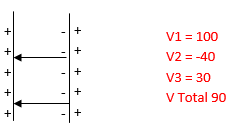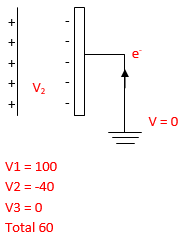Parallel Plate Capacitor Principle
Description:
We have already discussed what a parallel plate capacitor is. We know that more energy can be stored within a capacitor if the capacitance of a capacitor increases. This is possible only if the potential of capacitor is decreased, so that more number of charges can be stored within the capacitor before potential reaches to its breakdown voltage. To understand it experimentally, We make a parallel plate arrangement.
Step 1
Let a charge carrying plate is connected to a battery and let ‘q’ be the Charge acquired by the plate. Voltage due to the charge q be ‘V’. Now, a supporting plate is kept parallel to charge carrying plate. Due to induction, equal quantity of charge is inducted negative (-q) on the inner surface of the plate.

We know that, the potential decreases as the distance from the charge increases since,
V = 1/4πε0 q/R
let the potential of charge carrying plate due to its positive charges be 100 volt. Let potential at charge carrying plate due to negative charges of supporting plate be -40 volt and due to positive charges outside its surface be +30 volt. ( the magnitude of potential due to negative and positive charges of supporting plate is not same because the distance of positive charges of supporting plate is more from charge carrying plate as compared to negative charges of supporting plate) . So the resultant potential will be +90 Volt. As C = q/V and potential of charge carrying capacitor has decreased from 100 volt to 90 volt so, the capacitance will increase and more number of charge can be stored within the capacitor before potential reaches to its breakdown voltage.

Note
On placing a supporting plate parallel to charge carrying plate two effects are seen :
- The potential of capacitor decreases
- The capacitance of capacitor increases.
Step 2
Supporting plate is now connected to earth carrying zero potential. All the positive charges of supporting plate gets neutralized by the negative charges of earth.

This arrangement is known as parallel plate capacitor.
As a result, no positive charges in supporting plate would be creating potential at charge carrying plate as in step 1. So, the resultant potential on charge carrying plate will only be due to the charge carried on itself and negative charges of supporting plate.
So, if the potential of charge carrying plate due to its positive charges is 100 volt and the potential at the same plate due to negative charges of supporting plate is -40 volt, So the resultant potential will be +60 Volt. In this step, the potential further decreased. This implies, capacitance increased more by C=q /V.
Principle of parallel plate capacitor
Whenever a neutral conductor is brought near a charged conductor, the potential of charged conductor decrease. As potential decreases, the capacitance increases.
If supporting plate is earthed then its supporting power increases which will further decrease the potential and there by further increasing the capacitance, so that capacitor can store more charge.

